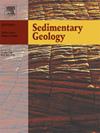波浪到潮汐主导的中新世浅海环境(阿根廷巴塔哥尼亚)中物理化学压力的技术指标
IF 2.7
2区 地球科学
Q1 GEOLOGY
引用次数: 0
摘要
对古生代演替中的生态学和沉积学特征进行综合分析,可为环境参数的高分辨率解释提供强大的数据集,其中包括沉积和生态两个方面。通过描述马德林港地层(阿根廷巴塔哥尼亚中新世晚期)中离散和重复出现的生物扰动模式,我们获得了有关横断相浅海和河口系统中主要环境压力的关键知识,揭示了其对古环境的影响。鉴于沿岸环境固有的复杂性,包括遗漏/侵蚀地表带来的挑战,考虑多种沉积过程和环境因素错综复杂的相互作用变得势在必行。通过对沉积学和生态学方法的详细整合,我们发现在以潮汐为主的河口系统之上建立了以波浪为主的系统。以波浪为主的海洋系统包括横向延伸数十公里的表层岩体,从中下游海面到近海陆架环境有向上细化和粗化的演替。在没有物理沉积结构的情况下,我们讨论了海浪和潮汐对这些系统的影响,并需要找到一些要素,使我们更接近于阐明海浪或潮汐过程是否影响了海岸表层到近海系统。通过水生态组合,可以确定 Cruziana 水生态的特征,包括近端(Taenidium 和 Thalassinoides)、原型(Asterosoma、Chondrites、Cylindrichnus、Ophiomorpha、?在下海岸表层到下近海以及与陆架的过渡环境中,这些沉积物的原型(Asterosoma、Chondrites、Cylindrichnus、Ophiomorpha、Rhizocorallium、Rosselia、Scolicia、Sinusichnus、Siphonichnus、Teichichnus 和 Thalassinoides)和远端表现(Chondrites、Helicodromites、Phycodes、Thalassinoides 和 Zoophycos)。潮汐主导的河口系统具有宽阔的河槽形水体,水体中充满了沙质至异质岩层,可解释为潮间带和潮下带沉积。为了区分河口和其他环境,分析涉及到横向和纵向表面特征、生物组合和面层分布,以确定沉积物的净移动--是向陆地移动还是向海移动--及其对系统分类的影响。生物组合可归入 Skolithos(Arenicolites、Gyrolithes、Maiakarichnus、Ophiomorpha、Schaubcylindrichnus、Skolithos 和 Thalassinoides)和 Cruziana 生物群(Ophiomorpha、Rosselia、Scolicia 和 Siphonichnus)。多样性和丰度的变化往往有助于确定某些应激条件,但讨论了向更开阔地区的过渡,探讨了如何改变丰度/多样性与物理化学应激直接相关的典型模式。本文章由计算机程序翻译,如有差异,请以英文原文为准。
Ichnological indicators of physico-chemical stresses in wave- to tide-dominated Miocene shallow marine environments (Argentine Patagonia)
An integrated analysis of ichnological and sedimentological features in ancient successions provides a robust dataset of high-resolution interpretations of environmental parameters, encompassing both depositional and ecological aspects. By characterising discrete and recurring bioturbation patterns in the Puerto Madryn Formation (Late Miocene, Argentine Patagonia), we arrive at key knowledge about predominant environmental stresses within transgressive phase shallow marine and estuarine systems, shedding light on their palaeoenvironmental implications. Given the inherent complexities of coastal settings, including the challenges posed by omission/erosion surfaces, it becomes imperative to consider the intricate interplay of multiple depositional processes and environmental factors.
Through a detailed integration of sedimentological and ichnological approaches, we discern the establishment of a wave-dominated system overlain by a tide-dominated estuarine system.
The wave-dominated marine system involves tabular bodies extending laterally over tens of kilometres, with upward fining and coarsening successions from the mid- to lower-shoreface to offshore-shelf environments. The influence of waves and tides on these systems is discussed in the absence of physical sedimentary structures and the need to find elements that bring us closer to elucidating whether waves or tidal processes influence shoreface to offshore systems. The ichnological assemblages allow for the characterisation of Cruziana ichnofacies with proximal (Taenidium and Thalassinoides), archetypal (Asterosoma, Chondrites, Cylindrichnus, Ophiomorpha, ?Rhizocorallium, Rosselia, Scolicia, Sinusichnus, Siphonichnus, Teichichnus, and Thalassinoides), and distal expressions (Chondrites, Helicodromites, Phycodes, Thalassinoides, and ?Zoophycos) in the lower shoreface to lower offshore and transitional settings with the shelf. However, the transition from these deposits to Chondrites-dominated beds associated with lower offshore to shelf environments—determined by changes in oxygenation, nutrients, and energy conditions—impedes assignment of all the successions to a particular ichnofacies.
The tide-dominated estuarine system features wide, channel-shaped bodies filled with sandy to heterolithic facies, interpreted as intertidal and subtidal deposits. To differentiate between estuary mouths and other settings, the analysis involved characterisation of transgressive and regressive surfaces, ichnological assemblages, and facies distribution, determining net sediment movement—whether landwards or seawards—and its influence on system classification. The ichnological assemblages could be assigned to the Skolithos (Arenicolites, Gyrolithes, Maiakarichnus, Ophiomorpha, Schaubcylindrichnus, Skolithos, and Thalassinoides) and Cruziana ichnofacies (Ophiomorpha, Rosselia, Scolicia, and Siphonichnus). Variations in diversity and abundance often help to determine certain stressful conditions, although the transition to more open areas is discussed, addressing how it could modify the typical models linked with a direct relationship between abundance/diversity and physico-chemical stress.
求助全文
通过发布文献求助,成功后即可免费获取论文全文。
去求助
来源期刊

Sedimentary Geology
地学-地质学
CiteScore
5.10
自引率
7.10%
发文量
133
审稿时长
32 days
期刊介绍:
Sedimentary Geology is a journal that rapidly publishes high quality, original research and review papers that cover all aspects of sediments and sedimentary rocks at all spatial and temporal scales. Submitted papers must make a significant contribution to the field of study and must place the research in a broad context, so that it is of interest to the diverse, international readership of the journal. Papers that are largely descriptive in nature, of limited scope or local geographical significance, or based on limited data will not be considered for publication.
 求助内容:
求助内容: 应助结果提醒方式:
应助结果提醒方式:


